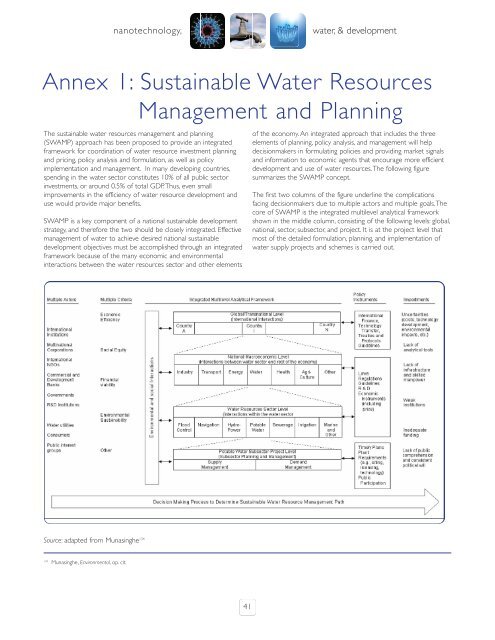Global Dialogue on Nanotechnology and the Poor ... - Nanowerk
Global Dialogue on Nanotechnology and the Poor ... - Nanowerk
Global Dialogue on Nanotechnology and the Poor ... - Nanowerk
Create successful ePaper yourself
Turn your PDF publications into a flip-book with our unique Google optimized e-Paper software.
nanotechnology,<br />
water, & development<br />
Annex 1: Sustainable Water Resources<br />
Management <strong>and</strong> Planning<br />
The sustainable water resources management <strong>and</strong> planning<br />
(SWAMP) approach has been proposed to provide an integrated<br />
framework for coordinati<strong>on</strong> of water resource investment planning<br />
<strong>and</strong> pricing, policy analysis <strong>and</strong> formulati<strong>on</strong>, as well as policy<br />
implementati<strong>on</strong> <strong>and</strong> management. In many developing countries,<br />
spending in <strong>the</strong> water sector c<strong>on</strong>stitutes 10% of all public sector<br />
investments, or around 0.5% of total GDP.Thus, even small<br />
improvements in <strong>the</strong> efficiency of water resource development <strong>and</strong><br />
use would provide major benefits.<br />
SWAMP is a key comp<strong>on</strong>ent of a nati<strong>on</strong>al sustainable development<br />
strategy, <strong>and</strong> <strong>the</strong>refore <strong>the</strong> two should be closely integrated. Effective<br />
management of water to achieve desired nati<strong>on</strong>al sustainable<br />
development objectives must be accomplished through an integrated<br />
framework because of <strong>the</strong> many ec<strong>on</strong>omic <strong>and</strong> envir<strong>on</strong>mental<br />
interacti<strong>on</strong>s between <strong>the</strong> water resources sector <strong>and</strong> o<strong>the</strong>r elements<br />
of <strong>the</strong> ec<strong>on</strong>omy. An integrated approach that includes <strong>the</strong> three<br />
elements of planning, policy analysis, <strong>and</strong> management will help<br />
decisi<strong>on</strong>makers in formulating policies <strong>and</strong> providing market signals<br />
<strong>and</strong> informati<strong>on</strong> to ec<strong>on</strong>omic agents that encourage more efficient<br />
development <strong>and</strong> use of water resources.The following figure<br />
summarizes <strong>the</strong> SWAMP c<strong>on</strong>cept.<br />
The first two columns of <strong>the</strong> figure underline <strong>the</strong> complicati<strong>on</strong>s<br />
facing decisi<strong>on</strong>makers due to multiple actors <strong>and</strong> multiple goals.The<br />
core of SWAMP is <strong>the</strong> integrated multilevel analytical framework<br />
shown in <strong>the</strong> middle column, c<strong>on</strong>sisting of <strong>the</strong> following levels: global,<br />
nati<strong>on</strong>al, sector, subsector, <strong>and</strong> project. It is at <strong>the</strong> project level that<br />
most of <strong>the</strong> detailed formulati<strong>on</strong>, planning, <strong>and</strong> implementati<strong>on</strong> of<br />
water supply projects <strong>and</strong> schemes is carried out.<br />
Source: adapted from Munasinghe 134<br />
134<br />
Munasinghe, Envir<strong>on</strong>mental, op. cit.<br />
41
















